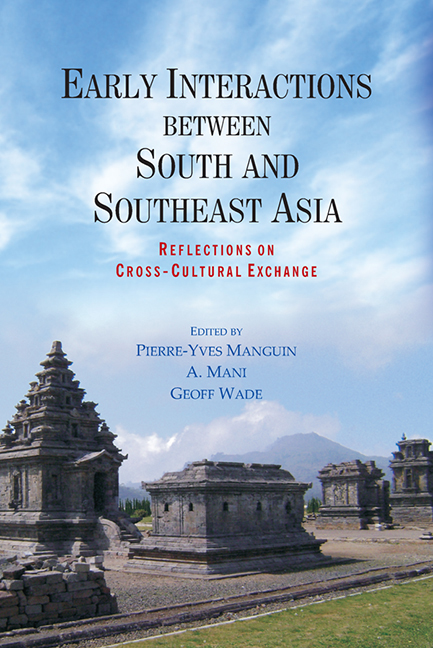Book contents
- Frontmatter
- Contents
- FOREWORD
- Preface
- Introduction
- PART I New Archaeological Evidence from South Asia and Southeast Asia
- 1 Central Vietnam during the Period from 500 BCE to CE 500
- 2 Ban Don Ta Phet and Khao Sam Kaeo: The Earliest Indian Contacts Re-assessed
- 3 Preliminary Study of Indian and Indian Style Wares from Khao Sam Kaeo (Chumphon, Peninsular Thailand), Fourth-Second Centuries BCE
- 4 Early Contacts between India and the Andaman Coast in Thailand from the Second Century BCE to Eleventh Century CE
- 5 The Batujaya Site: New Evidence of Early Indian Infl uence in West Java
- 6 Continuity and Change in South Indian Involvement in Northern Sumatra: The Inferences of Archaeological Evidence from Kota Cina and Lamreh
- 7 South Asia and the Tapanuli Area (North-West Sumatra): Ninth-Fourteenth Centuries CE
- 8 Emergence of Early Historic Trade in Peninsular India
- 9 Contacts between India and Southeast Asia in Ceramic and Boat Building Traditions
- 10 Marine Archaeological Investigations along the Tamil Nadu Coast and their Implications for Understanding Cultural Expansion to Southeast Asian Countries
- PART II Localisation in Southeast Asia
- LIST OF CONTRIBUTORS
- INDEX
6 - Continuity and Change in South Indian Involvement in Northern Sumatra: The Inferences of Archaeological Evidence from Kota Cina and Lamreh
from PART I - New Archaeological Evidence from South Asia and Southeast Asia
Published online by Cambridge University Press: 21 October 2015
- Frontmatter
- Contents
- FOREWORD
- Preface
- Introduction
- PART I New Archaeological Evidence from South Asia and Southeast Asia
- 1 Central Vietnam during the Period from 500 BCE to CE 500
- 2 Ban Don Ta Phet and Khao Sam Kaeo: The Earliest Indian Contacts Re-assessed
- 3 Preliminary Study of Indian and Indian Style Wares from Khao Sam Kaeo (Chumphon, Peninsular Thailand), Fourth-Second Centuries BCE
- 4 Early Contacts between India and the Andaman Coast in Thailand from the Second Century BCE to Eleventh Century CE
- 5 The Batujaya Site: New Evidence of Early Indian Infl uence in West Java
- 6 Continuity and Change in South Indian Involvement in Northern Sumatra: The Inferences of Archaeological Evidence from Kota Cina and Lamreh
- 7 South Asia and the Tapanuli Area (North-West Sumatra): Ninth-Fourteenth Centuries CE
- 8 Emergence of Early Historic Trade in Peninsular India
- 9 Contacts between India and Southeast Asia in Ceramic and Boat Building Traditions
- 10 Marine Archaeological Investigations along the Tamil Nadu Coast and their Implications for Understanding Cultural Expansion to Southeast Asian Countries
- PART II Localisation in Southeast Asia
- LIST OF CONTRIBUTORS
- INDEX
Summary
INTRODUCTION
The earliest evidence for medieval Tamil involvement in northern Sumatra currently comes from Lobu Tua near Barus on the west coast of the island. An inscription with a date equivalent to CE 1088 (Sastri 1932) announces the presence of the ticai ayirattu annurruvar – ‘The Five Hundred of a Thousand Directions’ who at Vorōcu, agreed amongst themselves certain dues (Subbarayalu 1998, 2002). Vorōcu, i.e. Barus, also called Fansur, was well known to Arab and Persian traders of the ninth century as a source of valuable forest products, benzoin and camphor, that came from the mountainous forested hinterland of this coast. It seems, however, that the profits to be made from the camphor trade attracted many different groups of traders who made their way to Barus, and these included Tamils as well as Javanese and others (Guillot 1998).
Not only has a Tamil inscription been found at Lobu Tua, but about one hundred years ago a Buddha image was recovered from this site (Anon 1899, 12). The image was destined to be sent to the museum in Batavia but it somehow disappeared en route. Unfortunately no description or illustration of the image has survived, but if one may speculate, based on the archaeological context in which it was found and what has been recovered at Kota Cina, then it was, in all likelihood, a provincial Chola style figure set up by the Tamil trading community. That a Buddha figure was recovered from this site is important in understanding the overall context of Tamil involvement at Barus, for like that at Kota Cina, it was in all probability erected by merchants who were adherents of a form of syncretic mercantile Buddhist/Saiva cult known as Cholappauttam, originally imported from Kerala to Tamilakam (southern India) and Ilam (Sri Lanka). This syncretic form of Buddhist/Saiva religion was practiced in mercantile port communities in southern India and northern Sri Lanka (Schalk 2005, 776, 841). Membership composition of the guilds was of a composite character, mostly being adherents of cults within the fold of Hinduism, but at the same time, eclectic, extending patronage to Saivaite, Vaisnavite and Buddhist institutions.
- Type
- Chapter
- Information
- Early Interactions between South and Southeast AsiaReflections on Cross-Cultural Exchange, pp. 137 - 160Publisher: ISEAS–Yusof Ishak InstitutePrint publication year: 2011



